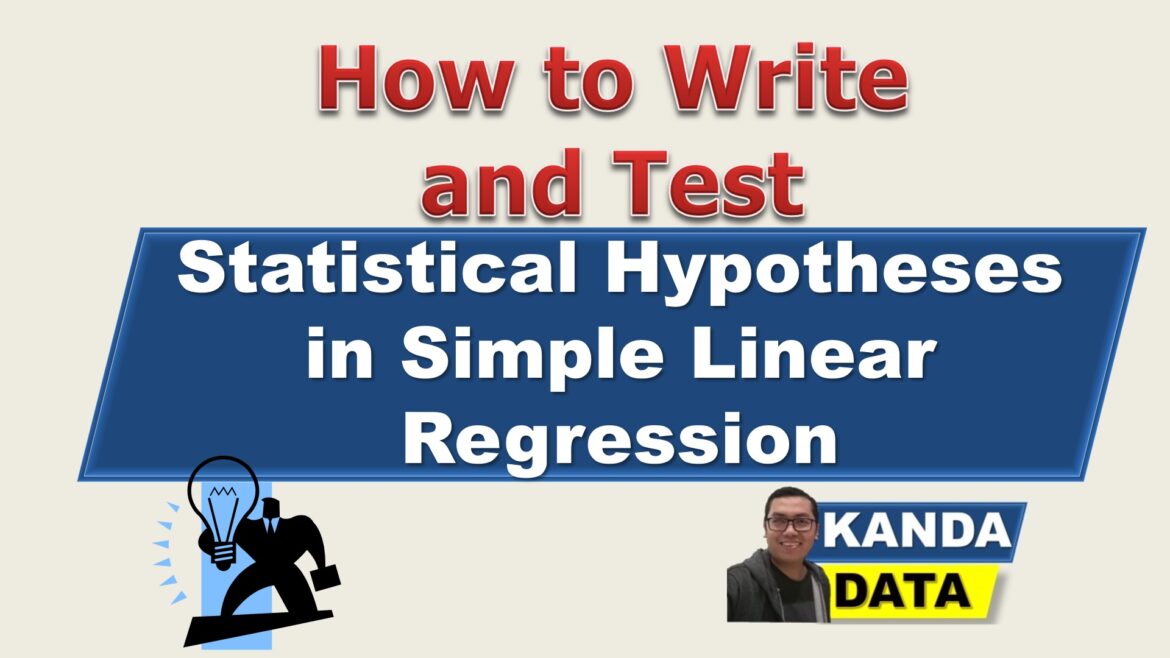Blog
How to Write and Test Statistical Hypotheses in Simple Linear Regression
We need to develop hypotheses when conducting research. A hypothesis is a provisional assumption or statement of the research. The hypothesis needs to be proven, whether true or false, through the research process.
To prove the hypothesis, we need to test the hypothesis to see whether the proposed hypothesis is accepted or rejected. On the other hand, researchers still use linear regression tools very often.
Therefore, on this occasion, Kanda Data will discuss how to write and test statistical hypotheses in simple linear regression. In principle, research hypotheses need to be derived into statistical hypotheses.
We can test whether the research hypothesis is accepted or rejected through this statistical hypothesis. Before discussing further, in hypothesis testing, we need to recognize the assumptions/statements, often referred to as the null hypothesis.
In developing statistical hypotheses, the null hypothesis is the hypothesis being tested. The notation H0 often expresses the null hypothesis.
In principle, if statistical hypothesis testing states that H0 is rejected, it can be interpreted that we accept the alternative hypothesis. Alternative hypotheses are often expressed with the notation H1 or Ha.
Mini Research Example
Suppose we conduct a mini-research to determine how price influences the volume of clothes sold. Because the ratio data scale measured both variables for this study, we can use a simple linear regression analysis.
Why do we use simple linear regression? The answer is that the regression equation used only consists of one independent variable and one dependent variable.
In this simple linear regression analysis, it is necessary to test the assumptions to obtain the best linear unbiased estimator. Test assumptions that need to be fulfilled, for example, normality, non-heteroscedasticity, and linearity tests.
How to Write a Statistical Hypothesis
Statistical hypotheses on simple linear regression can be written more simply and easily. This statistical hypothesis is a representation of your research hypothesis.
Based on the example of the mini-research that I conveyed earlier, the research hypothesis that we can propose is that price significantly affects the volume of clothing sales.
The research hypotheses can then be compiled into statistical hypotheses as follows:
H0: b = 0; clothing prices have no significant effect on clothing sales volume
H1: b ≠ 0; clothing prices have a significant effect on clothing sales volume
Determine the error significance level (alpha)
In testing the statistical hypothesis that has been compiled, the next step is to determine the level of significance of the error (alpha). Determination of the alpha significance level can be different for several types of fields of science.
For experimental research in general, the alpha significance level is set at 5% or 1%. Meanwhile, survey research can determine the alpha significance level of up to 10%.
Finding t-value
The t value in simple linear regression can be calculated manually or using statistical software. For manual t-value calculations, you can read my article entitled: “How to find the variance, standard error, and t-value in simple linear regression.”
If you determine the t-value using statistical software, the t-value will generally be in the coefficient table in the regression output. The advantage of using statistical software is that in addition to obtaining the t-value, we can also directly find out the p-value of alpha.
Hypothesis test
Statistical hypothesis testing can use the one-tailed test and the two-tailed test. Based on the previous statistical hypothesis, I used a two-tailed statistical test.
In testing the hypothesis, it can be determined in two ways: comparing the t-value with the t-table and comparing the p-value of the regression output with the alpha significance level.
The statistical hypothesis testing criteria for the 1st method are:
If t-value ≤ t-table, H0 is accepted (H1 is rejected)
If t-value > t-table, H0 is rejected (H1 is accepted)
Because we are using a two-way test, the value of t can be positive and can be negative. Thus, Ho is rejected if t-value>t-table or -(t-value)<-(t-table), and vice versa.
Furthermore, for the statistical hypothesis testing criteria for the 2nd method, namely:
If p-value ≥ alpha, H0 is accepted (H1 is rejected)
If p-value < alpha, H0 is rejected (H1 is accepted)
For example, the t value of the regression output is -6.604 with a p-value <0.05, it can be concluded that we reject H0 (accept H1). Therefore, we can conclude that clothing price has a significant effect on the volume of clothing sales.
Well, that’s our discussion this time. I hope it will be beneficial for all of us. See you in the following article!
1 comment
Leave a Reply
You must be logged in to post a comment.

Pingback: How to Test Hypotheses in Regression Analysis, Correlation, and Difference Tests - KANDA DATA